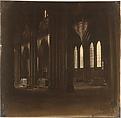Salisbury Cathedral - The Nave, from the South Transept
Roger Fenton British
Not on view
The dark interiors of Gothic cathedrals posed a particular challenge to early photographers. By leaving the shutter open perhaps as long as several hours, Fenton achieved the technical tour de force of making clearly legible the cathedral's lofty ordinance while at the same time registering the nuances of semidarkness peculiar to the Gothic space.
Salisbury Cathedral, in Wiltshire, is seen here from the south transept looking northwest. Built over the unusually short period of only thirty-six years, from 1220 to 1256, it stands out among the English cathedrals for the uniformity and harmony of its design. The interior, however, is generally thought to lack warmth, the result of the loss of the original stained-glass windows and of the radical restoration carried out by James Wyatt in 1788-89, in which screens and chapels were removed and funerary monuments rearranged in tidy rows. Ironically, these unfortunate changes may well have contributed to Fenton's success with the photograph. The absence of stained glass made for more light, and the order brought to the interior exposed its essential lines.
Due to rights restrictions, this image cannot be enlarged, viewed at full screen, or downloaded.

